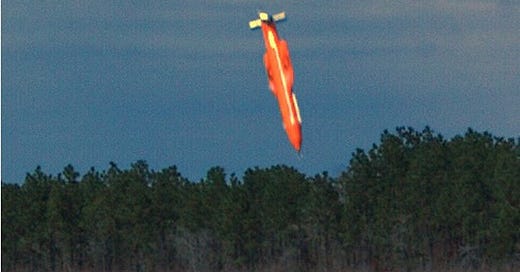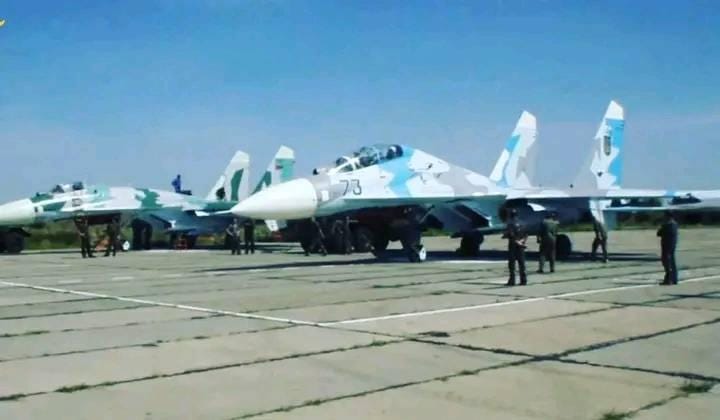The 'Mother of All Bombs' the U.S. Dropped on Afghanistan Was Nasty, But Mostly for Show
It's unclear how much damage the bomb caused to its intended target—an ISIS tunnel complex—but it may not have mattered.
This story appeared in Vice in 2017.
On April 13, 2017, U.S. forces dropped—for the first time ever in combat—one of the world’s most powerful non-nuclear weapons on ISIS fighters in eastern Afghanistan.
There’s a good chance it was mostly for show. And the audience wasn’t necessarily limited to ISIS.
A U.S. Air Force MC-130 transport lobbed the 11-ton Massive Ordnance Air Blast (MOAB) bomb—a so-called “fuel-air explosive”—at what the U.S. Defense Department described as a “tunnel complex” in Achin district in Nangarhar province.
“The strike was designed to minimize the risk to Afghan and U.S. forces conducting clearing operations in the area while maximizing the destruction of [ISIS] fighters and facilities,” the Pentagon stated.
It’s unclear exactly how much damage the 30-foot-long bomb inflicted on the tunnel complex. And it might not really matter. When the United States deployed similar munitions in the past, the psychological effect was at least as important as the actual physical impact.
The same thinking could be behind the current bombing. Recall what then-U.S. presidential candidate Donald Trump said in September 2016. “I’m going to make our military so big, so powerful, so strong, that nobody—absolutely nobody—is going to mess with us.”
How better to inspire fear than to detonate one of the world’s most powerful munitions?
Fuel-air explosives, or FAEs, have two major components: a tank of compressed liquid fuel and an explosive charge. The tank bursts at a predetermined height above the ground, spreading a cloud of fuel that covers a wide area—potentially a hundred acres or more—and also fills enclosed spaces such as buildings and tunnels.
Next, the charge explodes, igniting the cloud of fuel.
The results can be devastating. In 2000, Human Rights Watch quoted a 1993 U.S. Defense Intelligence Agency report on fuel-air explosives. “The [blast] kill mechanism against living targets is unique—and unpleasant,” the DIA explained. “What kills is the pressure wave, and more importantly, the subsequent rarefaction [vacuum], which ruptures the lungs.”
“If the fuel deflagrates but does not detonate, victims will be severely burned and will probably also inhale the burning fuel,” the DIA continued. “Since the most common FAE fuels, ethylene oxide and propylene oxide, are highly toxic, undetonated FAE should prove as lethal to personnel caught within the cloud as most chemical agents.”
Fuel-air explosives are terrifying to their targets. And the military knows it. During the 2003 US-led invasion of Iraq, the Air Force dropped several, old Vietnam War-era “Daisycutter” FAEs. The nickname comes from the munitions’ ability to instantly chop down huge swathes of forest.
The Air Force used the Daisycutters for their “psychological effect,” according to a 2003 account of U.S. military psychological operations written by Daniel Haulman of the Air Force Historical Research Agency. Combined with propaganda efforts, the Daisycutters helped convince thousands of Iraqi troops to surrender, according to Haulman.
In 2003, the Pentagon hoped to double down on the psychological impact of fuel-air explosives by fielding a bigger and more powerful weapon than the seven-ton Daisycutters. In late 2002, as Americans forces were gathering in the Middle East, the Air Force Research Laboratories rushed the MOAB through development, hoping to complete it before the invasion launched.
Air Force researchers partnered with Dynetics, an Alabama engineering firm. “In only three months, the MOAB preliminary concept was developed into a detailed design, fabricated and proven by a flight test program of three successful guided flight tests conducted over a span of only 13 days,” Dynetics boasted on its website. “MOAB was then produced and available to the warfighter during the early days of the Iraq conflict.”
U.S. forces didn’t actually use any MOABs in 2003. The massive bombs would remain in reserve until April 2017. But the Pentagon loudly boasted of the MOAB’s destructive potential, apparently hoping to leverage the weapon for its psychological impact without ever detonating it. The Defense Department published photos and videos of the weapon’s testing and openly discussed the bomb’s deployment to the Middle East.
The propaganda worked, perhaps too well. The MOAB became a symbol of American firepower even as the Iraq war shifted to a counterinsurgency, in which winning hearts and minds is arguably more important than inspiring fear.
One U.S. Army commander who fought in southern Iraq in the summer of 2003 even expressed his desire to wipe out an ambivalent community … by dropping a MOAB on it. “Each day we alienate the population more and more in the Abu Hishma tribe. It’s one of the towns that would best serve Iraq with a MOAB … placed in its epicenter,” Todd Brown, then a captain, wrote in his journal, which he later published as a memoir entitled Battleground Iraq: Journal of a Company Commander.
The MOAB remained a potent but unused weapon in the U.S. arsenal for 14 years before the Pentagon finally made good on the implicit threat … and detonated one of the massive fuel-air bombs over ISIS positions in Afghanistan.
True to form, the Pentagon quickly announced it had used the bomb, amplifying its psychological effect. “This is the right munition to … maintain the momentum of our offensive,” stated Army general John Nicholson, then-commander of U.S. forces in Afghanistan.
Read more:
In 2006, Ethiopia's New Sukhoi Su-27 Fighters Spearheaded an Invasion of Somalia
Ethiopia’s tiny air force, which in the early 2000s was in danger of implosion, spearheaded the December 2006 assault into southern Somalia to drive out Islamic Courts and their militia forces. Beginning on Dec. 24, 2006, Sukhoi Su-27 Flanker fighter-bombers hit strategic targets and even struck ground troops while at least 3,00…






